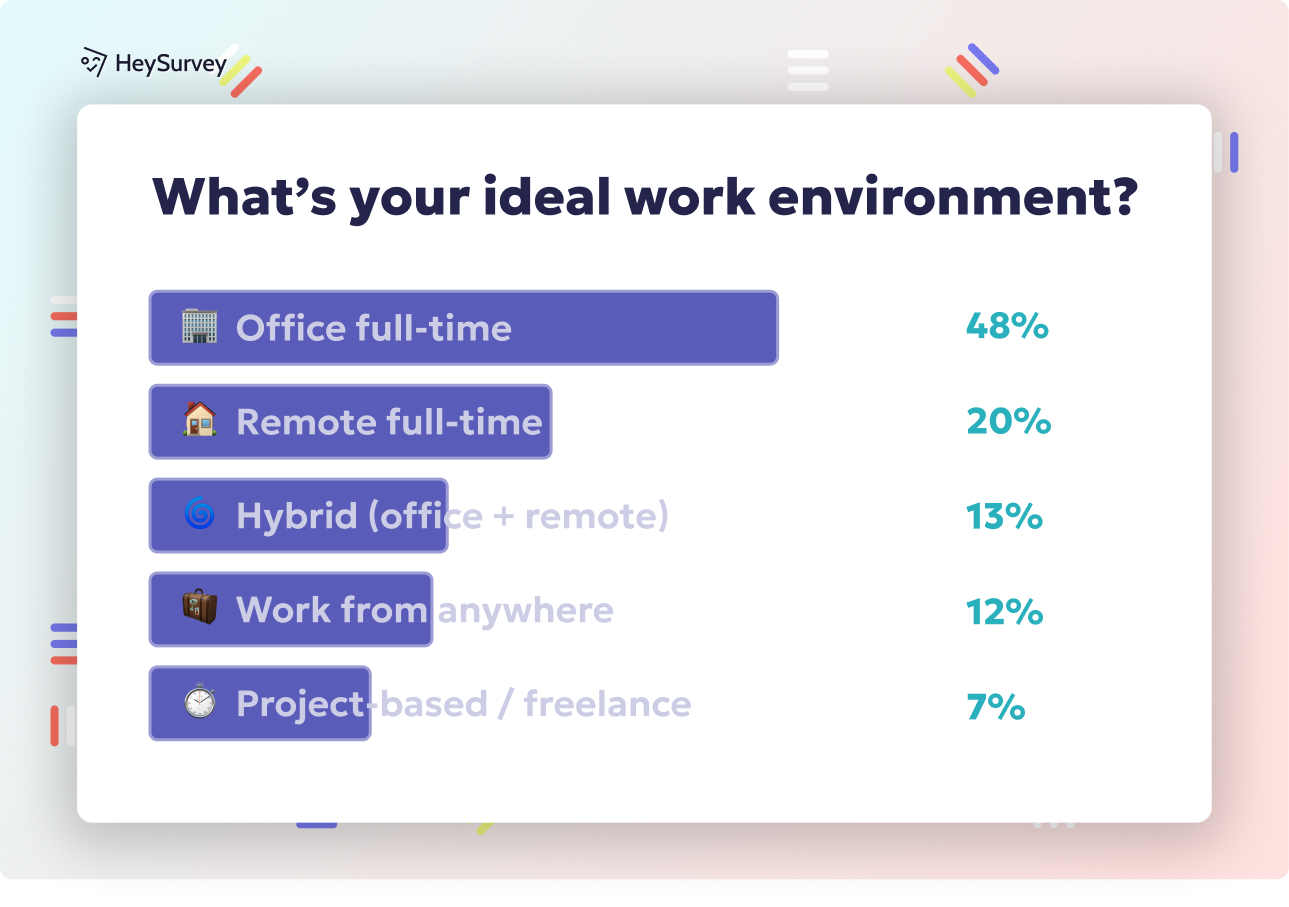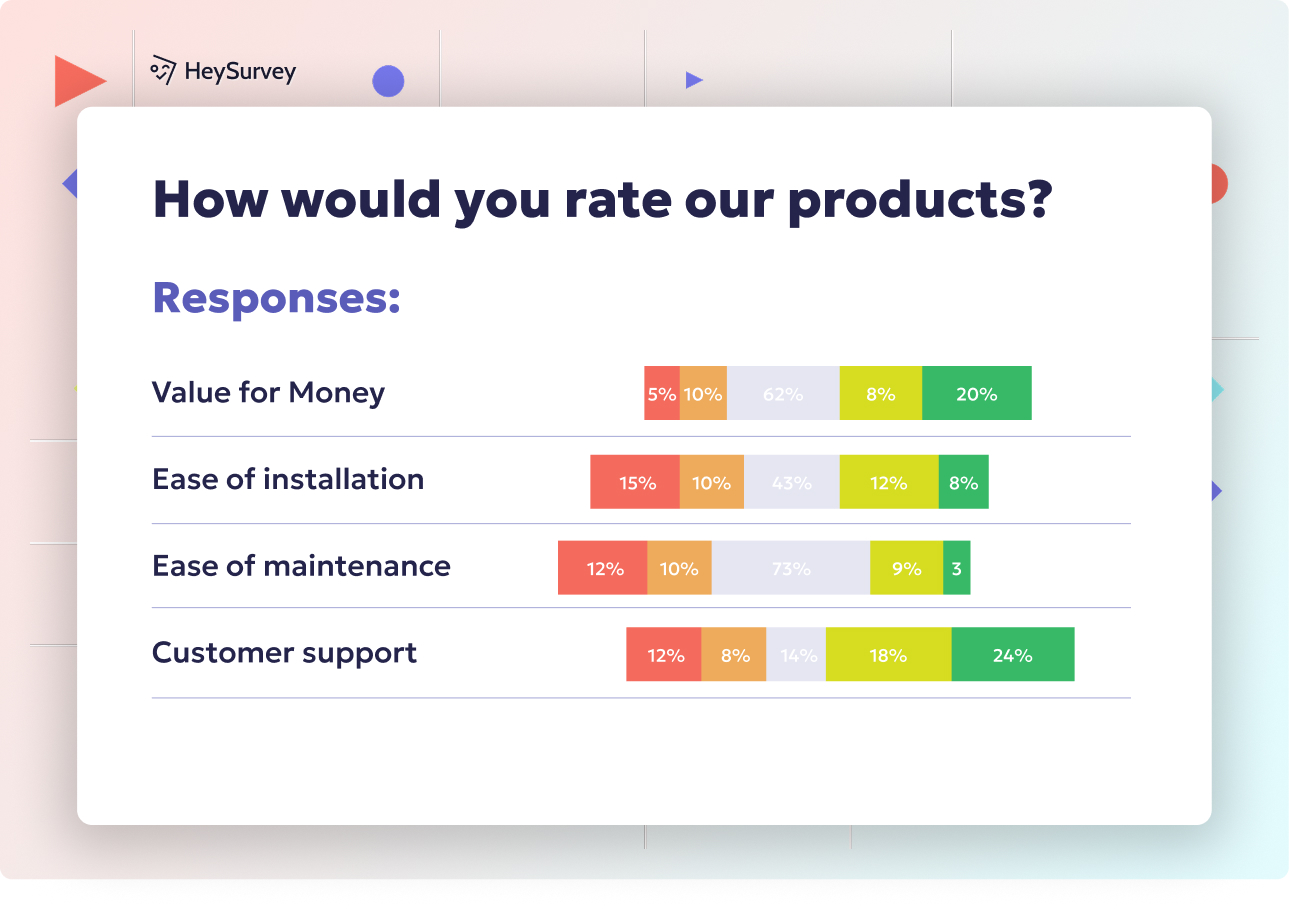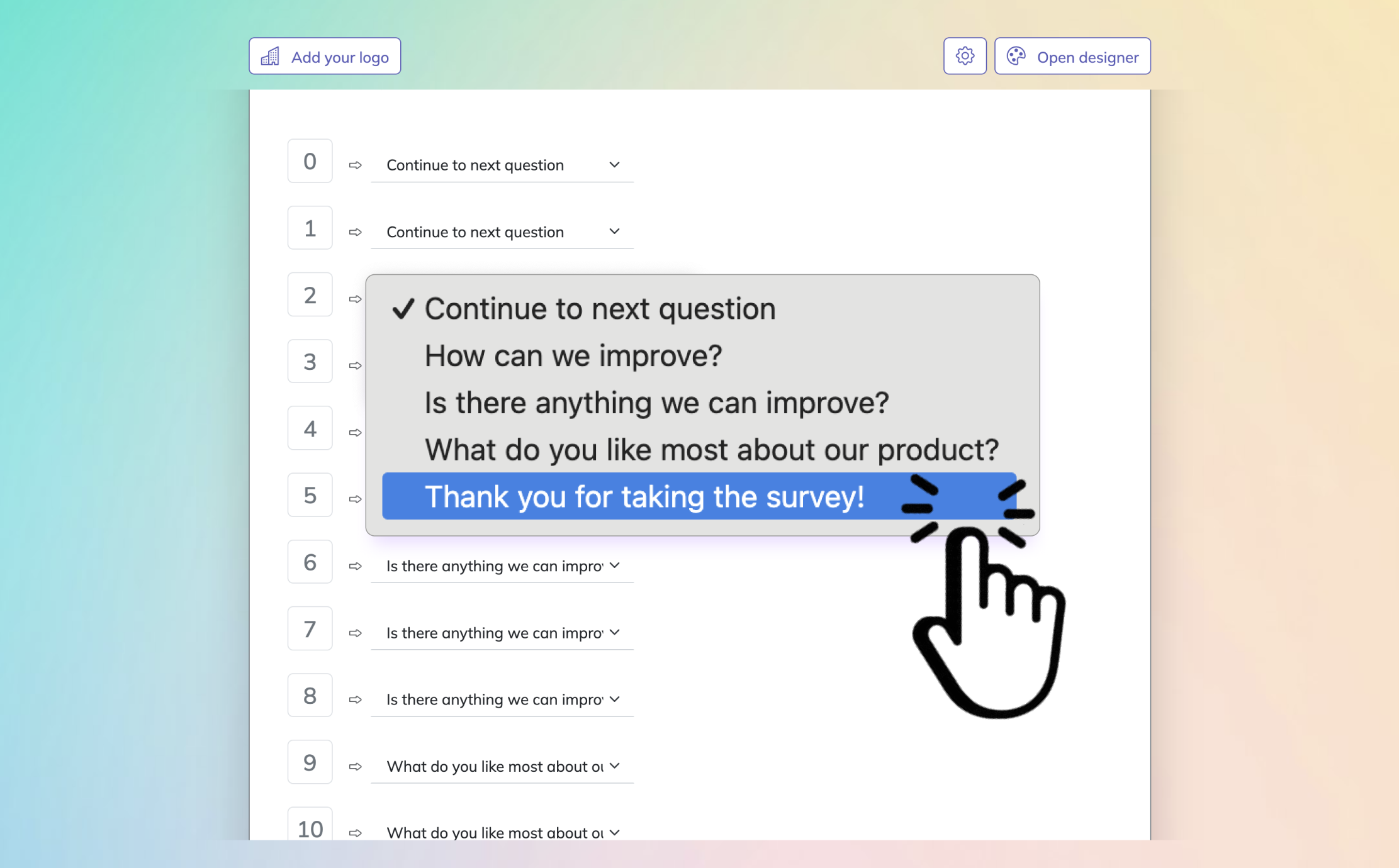28 Workplace Bullying Survey Questions for Effective Assessment
Discover 25 insightful workplace bullying survey questions to help you address and prevent bullying at work. Perfect for HR assessments.
If you’re worried about workplace drama becoming workplace disaster, workplace bullying survey questions are your best secret weapon. Bullying and harassment tank morale, productivity, and even profits. Worse, they break trust—sometimes before HR even knows there's a problem. Hotlines and open-door policies are nice, but surveys deliver the anonymous honesty, consistent data, and quick pulse you need to spot trouble early. Here’s your toolkit: eight wickedly effective bullying survey types to fight back, plus plenty of bullying survey questions you can use right now. Ready to create a safe, happy, drama-free office? Let's jump in.
Employee Pulse Bullying Climate Survey
Why & When to Use
Want a quick snapshot of your company’s vibe? The Employee Pulse Bullying Climate Survey is your best bet. It brings you a monthly or quarterly temperature check of how everyone’s feeling about respect—or the lack thereof—at work.
This bullying survey puts you in the driver’s seat, helping HR catch hostility before it turns into a formal complaint. Think of it as an early-warning system, like a weather app for workplace clouds.
Team drama rarely explodes overnight. Usually, subtle signals like eye-rolls, sarcasm, or group chats gone rogue start first. Employee pulse surveys sniff these out and help you spot rising bullying risk before it takes over.
You’ll also get data trends instead of isolated complaints. That’s gold for leadership—it helps you clearly see if anti-bullying training is actually working, or just making nice PowerPoint slides.
You'll want to leverage these insights to build trust, tweak culture strategy, and turn your workplace from cringe to kind. Plus, anonymous pulse surveys often get way more honest feedback than hotlines or manager “check-ins.” The right survey questions make people feel seen, not targeted.
5 Sample Questions
In the past 30 days, how often have you witnessed or experienced belittling remarks at work?
I feel safe reporting bullying or harassment without fear of retaliation. (5-point Likert)
My manager addresses disrespectful behavior promptly.
Rate your agreement: “Team meetings are free from sarcasm, ridicule, or personal attacks.”
What one change would most reduce bullying in your department? (open-ended)
The 13‑item NAQ‑R Short Form, refined via item response theory, reliably measures workplace bullying with strong validity and no sex bias Source

Certainly! Here’s a clear, three-step instruction for creating a survey with HeySurvey—even if you’ve never used it before. Bonus personalization steps are included at the end. Get started in seconds using the template button below these steps!
How to Create a Survey with HeySurvey in 3 Easy Steps
Step 1: Create a New Survey
- Click the Start with Template button below these instructions to open a pre-built survey template.
- You’ll instantly enter the HeySurvey Survey Editor, where you can give your survey an internal name.
Step 2: Add or Customize Questions
- Use the Add Question button to create new questions, or click on any existing question to edit or customize it.
- Choose from a variety of question types—multiple choice, scale, text, file upload, and more.
- Make questions required, add images, and format your text as needed!
Step 3: Publish Your Survey
- When you’re happy with your survey, click Publish in the top-right corner.
- Sign in or create an account (required for publishing and sharing).
- Copy your survey link or embed the survey on your website—ready to collect responses!
Bonus Steps: Make Your Survey Stand Out
- Apply Branding: Upload your own logo and customize survey colors, fonts, and backgrounds using the Designer Sidebar.
- Define Survey Settings: Set response limits, schedule start/end dates, or add a redirect URL for completed surveys from the Settings Panel.
- Create Branches: Use Branching to personalize the flow—show different questions or endings depending on answers (works great for screening or segmenting respondents).
Ready to try? Click the Start with Template button below to launch your new survey setup instantly!
Need help? Scroll down for a detailed overview of HeySurvey features and screenshots.
Anonymous Incident-Reporting Survey
Why & When to Use
Let’s face it, sometimes people don’t want to drop by HR for a chat—especially when the bully’s the boss or the situation feels intimidating. Anonymous incident-reporting surveys create a safe zone for sharing details, minus the awkward face-to-face.
These bullying survey questions kick in the moment there’s an event: think shouting, exclusion, or cyberbullying. Employees can sound the alarm, document what happened, and note if there are any witnesses, all without risking retaliation.
You keep records for future investigation questions for bullying in the workplace, and employees get a voice, even when whisper networks fail. Plus, when you’re dealing with recurrent issues or gray areas, the data stockpile helps show patterns other systems miss.
The best part? You get to ask the hard questions, collect investigation-ready data, and protect your people all at the same time. Plus, having these reporting tools boosts your reputation—especially for the silent majority who crave accountability.
Anonymous surveys are especially effective after all-hands meetings or employee communications about workplace conduct. Why? They let you see if the messages landed—or bounced.
5 Sample Questions
Date & time of the bullying incident.
Role of the person exhibiting bullying behavior (peer, supervisor, client, other).
Describe the behavior (e.g., shouting, exclusion, cyberbullying).
Were there witnesses willing to corroborate?
Preferred follow-up: HR investigation, mediation, no contact, etc.
A recent U.S. survey found that 84.5% of employees would be more inclined to report harassment if they could do so completely anonymously. 84.5 percent preferred anonymity
Post-Incident Investigation Survey
Why & When to Use
Here’s the thing: after a formal complaint, details matter. The post-incident investigation survey digs for specifics so investigators don’t miss the full picture.
Timing is everything. You want to send this within 48 hours and keep the questions clear and relevant, like your best detective kit for workplace harassment survey questions.
By structuring your investigation questions for bullying in the workplace, you build a chain-of-custody from the allegations to the evidence. That keeps your case strong, your process transparent, and your legal team happy.
Confidentiality is non-negotiable here. All information must be handled securely, with only authorized staff involved in the review. This reassures everyone—victims, witnesses, and the company itself—that complaints are taken seriously.
Plus, don’t just ask for “what” happened. Ask about “impact” and “resolution.” Sometimes the best solutions are born from open-ended questions and listening for the emotional fallout.
5 Sample Questions
What impact did the incident have on your ability to work?
Have there been prior incidents with the same individual?
Please identify any emails, messages, or documents relevant to the case.
Which company policies do you believe were violated?
What resolution would you consider satisfactory?
Bystander Perception Survey
Why & When to Use
A lot of bullying goes unreported, but not unnoticed. The bystanders see it all—silent, awkward, and a little worried they’ll be next. That’s where a bystander perception survey changes the game.
This type of bullying survey questions the silent majority, who might not report directly but are critical in shifting culture. You catch important clues about blind spots and untapped champions of respect in your organization.
Use these bullying survey questions quarterly, or after anti-bullying trainings. The insights show if your team feels empowered to act, or if fear is still running the show.
Plus, you can quickly spot if reporting tools are easy, trusted, and understood. That feedback shapes your next rollout of whistleblower or support systems.
The real win: By asking what would help people intervene safely, you find practical ways to move bystanders from “not my circus” to “I’ve got your back.”
5 Sample Questions
I feel empowered to speak up when I see a colleague being bullied.
How confident are you that HR will act on third-party reports?
List behaviors you’ve observed that you believe qualify as bullying.
Have you used the organisation’s reporting tools? Why or why not?
What training or resources would help you intervene safely?
Here’s a key research finding related to bystander perception in workplace bullying:
Witnessing workplace bullying significantly lowers work engagement in bystanders and increases turnover intentions, especially for those adopting outsider or assistant roles. [source]
Longitudinal study: witnessed bullying, bystander roles and work outcomes
Leadership Accountability Survey
Why & When to Use
Respect starts at the top. A leadership accountability survey gives you a front-row seat to how managers model (or mangle) workplace behavior.
This survey isn’t just for feedback’s sake. It’s a 360-degree checkup—are managers walking the talk? Are they quick to act on reports, or do they shrug things off? These bullying survey questions capture the real story.
Rated annually, this survey lights up strengths and gaps in your anti-bullying leadership playbook. Plus, it supports coaching and helps reward genuine champions, not just those who know how to talk good game in HR workshops.
Here’s the thing: When leadership is held accountable, everyone feels safer about speaking up. Staff trust rules apply equally, and it’s clear retaliation has no place.
And yes, an honest review lets you spot sketchy patterns before they become lawsuits-with-a-capital-L.
5 Sample Questions
My manager models respectful communication at all times.
Feedback about bullying is taken seriously and acted upon quickly.
Rate how consistently your leader enforces anti-bullying policies.
Leadership encourages open dialogue about workplace harassment.
Provide an example of a recent constructive intervention by your leader.
Exit-Interview Bullying & Harassment Survey
Why & When to Use
When someone’s walking out the door, ask the hard questions—it's your last, best shot for radical candor. This exit-interview bullying and harassment survey uncovers what staying employees won’t (or can’t) say out loud.
These bullying survey questions invite honesty by design. Departing employees have less to lose, so they’ll flag unreported incidents, loopholes in your system, or entire departments with “birds of a feather” vibes.
Catch these insights, fix bubbling trouble spots, and prevent another costly goodbye. Plus, you’ll see if bullying or harassment played a role in someone’s decision to leave.
Answer patterns over time give you rich data for improving culture and retention—win-win!
Here’s the twist: Mix open-ended and direct questions in this bullying survey. You might be surprised by what “the ones that got away” reveal.
5 Sample Questions
Did bullying or harassment influence your decision to leave?
Describe any unreported incidents you experienced or witnessed.
How effectively were previous concerns addressed?
Would you recommend this company to friends? Why or why not?
What single policy change would have improved your experience?
Training Effectiveness & Culture Reinforcement Survey
Why & When to Use
You’ve run the training, handed out the coffee, and watched your team nod during the PowerPoint. Here’s how you see if it actually worked. The training effectiveness and culture reinforcement survey clarifies what stuck, what faded, and what needs a tune-up.
Drop this survey 30–60 days post-training. You’ll measure retention, spot behavior changes, and crowdsource new ways to reinforce anti-bullying culture.
Ask these workplace bullying survey questions right after workshops, during onboarding, or following e-learning refreshers. The feedback is pure magic for your next session—and for fixing snooze-worthy content.
The best part? When people feel like their opinions shape future training, they invest more in making culture stick. It’s also a clever way to surface new bullying survey questions for future use.
Keep this one short, practical, and grounded in real life—not just policy gobbledygook.
5 Sample Questions
I can identify behaviors that constitute workplace bullying.
The training provided actionable steps for addressing harassment.
Have you applied any techniques from the training? Provide examples.
What topics need deeper coverage in future sessions?
Overall, rate the training’s impact on team civility.
Best Practices: Dos and Don’ts for Crafting Workplace Bullying Surveys
Creating a great bullying survey isn’t just about asking the tough stuff. Best practices make sure you get honest, useful answers—not legal headaches or half-truths.
Here’s your checklist for building effective workplace bullying survey questions:
Do keep surveys anonymous unless legal documentation is required
Do combine scaled, multiple-choice, and open-ended questions for richer data
Do use neutral, non-accusatory wording to avoid bias
Don’t ask leading questions that imply wrongdoing
Don’t store identifying data in the same location as responses; ensure GDPR/CCPA compliance
Do communicate survey results and action plans to build trust
Double-check for emotional tone, bias, and legal landmines—especially in investigation questions for bullying in the workplace.
Plus, always explain why you’re surveying and how you’ll follow up. Transparency equals trust, and your employees will notice. Remember, HeySurvey is free, forever—no gatekeeping, no fine print.
If you include a checklist on your site, double the impact by making it downloadable.
The magic of bullying survey questions is simple: you get a 360º view of risk, improvement, and progress—before, during, and after trouble hits. Mix and match these survey types for a custom bullying survey strategy that actually works. Ready to transform reporting? Download our workplace harassment survey questions PDF, or check out real-world success stories at site:heysurvey.io to see how teams like yours cut turnover and speed up investigations. When employees feel safe, creative, and heard, you gain an unbeatable edge. Make psychological safety your superpower—starting today.
Related Employee Survey Surveys

29 Essential Post Mortem Survey Questions for Project Success
Discover 25+ essential post mortem survey questions to improve projects, boost team morale, and d...

31 Change Readiness Survey Questions to Boost Your Success
Discover 25+ sample change readiness survey questions to assess attitudes, barriers, and confiden...

31 Retreat Survey Questions to Collect Actionable Feedback
Discover 26 essential retreat survey questions to gather actionable feedback before, during, and ...
